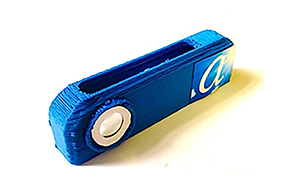Press Release
Johns Hopkins Applied Physics Laboratory Reports Record Year for Technology Transfer Efforts
Wed, 12/10/2014 - 10:33

The Johns Hopkins University Applied Physics Laboratory (APL), in Laurel, Maryland, had a record-breaking year for transferring technologies to commercial industry in 2014. The Laboratory launched six start-up companies, filed disclosures for 257 inventions, and recorded 77 agreements to license APL-developed technologies, according to APL’s Office of Technology Transfer.
“We are pleased to see these record-setting numbers for several indicators of innovation,” said Norma Lee Todd, the head of APL’s Office of Technology Transfer. “The increases we’ve seen over the past year are a direct reflection of the vision and ingenuity of our staff members, the resourcefulness of our technology transfer team, and the contributions from Lab partners in industry and government.”
The number of invention disclosures increased by 12 percent from fiscal 2013. They vary widely in subject matter and include technology enabling a scalpel with integrated circuits that tells the user what type of tissue they are cutting; a socially networked air-quality monitor; and light-fidelity technology for autonomous transportation and improved situational awareness.
Compared with previous years, there was an increase in biomedical-technology disclosures, likely related to APL’s strategic focus on health care, said Heather Curran, senior technology manager in the office. “There has also been a rise in bio-related sensors and information processing,” she added, “and it’s also no surprise, given APL’s strong background in space, that the recent public spotlight and growing commercial investment coincide with an increasing rate of APL disclosures for space and environmental sensors.”
License agreements increased from 40 to 77, continuing a trend fueled, in large part, by APL’s efforts to create a climate of discovery and invention. For example, the tech transfer program continues to work with staff members to capture, evaluate, protect and license intellectual property. It hosts internal events, such as the “Innovation Exchange” speaker series featuring leading entrepreneurs and business leaders from companies like SpaceX and Honest Tea. The Laboratory also hosts an annual Technology Achievement Awards to honor staff member innovations.
Increasingly, staff members are hearing from sponsors that technology transfer is important and remains a priority for the president and Congress, Curran added.
“In his fiscal year 2015 budget, the president announced a ‘Lab-to-Market’ goal to increase the economic impact of federally funded research and development by improving and accelerating technology transfer from federal labs to the commercial marketplace,” she said.
Laboratory innovations led to six start-up companies last year, bringing the total of APL spinoffs to 34 since fiscal 2000. Those companies are:
- NexGen Forensic Science, which is marketing a technology that can identify each individual involved in a “real-world” crime scene
- Articu-Tech, an educational company focused on exploring the science and technology behind mobile devices
- Cognoscenti Systems, a cybersecurity firm
- Reality, Inc., which will leverage an APL-developed portable mapping system—carried in a backpack—that can be used to create annotated physical maps of locations where GPS is not available, such as in underground areas and on ships
- WREN Scientific, LLC, providing home-care products for asthmatic patients
- Bioreactors Technologies, LLC, which intends to bridge the expensive development gap between laboratory research and biomedical tools suitable for FDA trials
Todd said that several of these new businesses are a direct result of APL’s partnership with the Maryland Center for Entrepreneurship. In August 2013, APL and the center established a technology transfer partnership to create new companies and accelerate commercialization of targeted technologies, many developed at APL for government use.
“We have some of the most creative and hardworking researchers in the world, and the discoveries they are making and the technologies they are developing can address industry needs that benefit our sponsors, the public and the university as well as foster economic development in Maryland and beyond,” Todd said. “The Office of Technology Transfer is the link between viable APL research and technologies and commercial companies who can transition them to the local, national and international marketplace.”